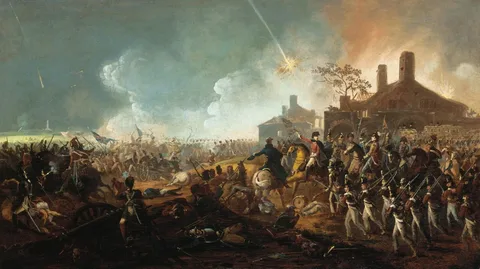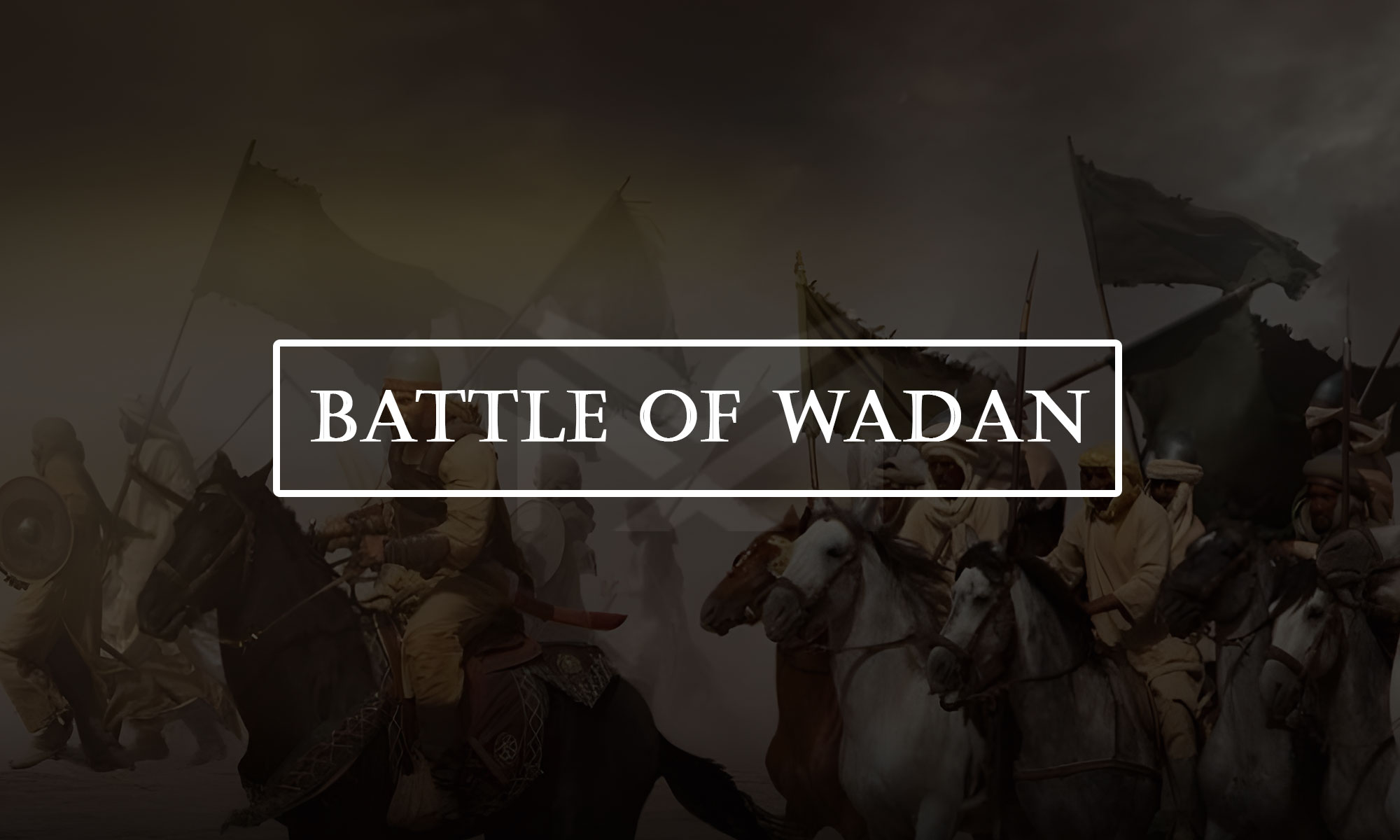The Battle of Waddan, also known as the Expedition of Waddan or Ghazwat Waddan, holds a significant place in Islamic military history as the first expedition personally led by Prophet Muhammad after the establishment of the Muslim community in Medina. Taking place in the first year of the Hijri calendar (622-623 CE), this expedition marked the beginning of a series of military campaigns that would shape the early development of the Islamic state and its relationship with the surrounding Arabian tribes.
The battle of Waddan

The migration (Hijra) of Prophet Muhammad and his followers from Mecca to Medina in 622 CE marked a pivotal moment in Islamic history. This event not only established the first Islamic state but also initiated a period of intense political and military activity as the nascent Muslim community sought to establish its position in the complex tribal landscape of the Arabian Peninsula.
Following the Hijra, the Muslim community in Medina faced numerous challenges. The Meccan Quraysh tribe, which had expelled the Muslims from their homeland, continued to pose a significant threat. Trade routes that had been vital to Meccan prosperity passed through territories that were now within the sphere of influence of the Muslim community. The control of these routes became a crucial factor in the emerging conflict between Mecca and Medina.
The Arabian Peninsula during this period was characterized by a complex network of tribal alliances, trade relationships, and territorial disputes. Tribes often engaged in raids and counter-raids, seeking to protect their interests and assert their dominance over specific territories and trade routes. Within this context, the Muslim community’s military expeditions were not merely aggressive actions but strategic moves necessary for survival and consolidation of power.
The Strategic Importance of Waddan
Waddan, located approximately 60 kilometers northwest of Medina, was strategically positioned along one of the major trade routes connecting Syria to Mecca. This location made it a vital point for controlling commercial traffic and asserting influence over the economic activities of the region. The area was frequented by Meccan trade caravans, making it an ideal location for the Muslims to demonstrate their growing power and potentially intercept valuable goods.
The choice of Waddan as the target for the first major expedition was not arbitrary. It represented a calculated decision to challenge Meccan commercial interests while avoiding direct confrontation with the main Meccan military forces. By targeting this location, Prophet Muhammad demonstrated the Muslim community’s capability to project power beyond Medina’s immediate vicinity and threaten the economic lifelines of their adversaries.
Read more: the story of Prophet Zakariya
The Expedition: Planning and Execution
The expedition to Waddan was meticulously planned and executed under the direct leadership of Prophet Muhammad. Historical sources indicate that the force consisted of approximately 70 to 80 Muslim fighters, primarily from the Muhajirun (emigrants from Mecca) and some Ansar (helpers from Medina). This relatively small force reflected both the limited military resources of the early Muslim community and the expedition’s primary nature as a reconnaissance and demonstration of strength rather than a major military campaign.
The preparation for the expedition involved careful consideration of logistics, route planning, and timing. The Muslim force needed to traverse the desert terrain while carrying sufficient supplies for the journey. The timing was crucial, as it needed to coincide with the expected passage of Meccan caravans through the area.
Prophet Muhammad’s personal leadership of this expedition was significant for several reasons. It demonstrated his commitment to the military aspects of establishing the Islamic state and provided an opportunity for him to gain firsthand experience in leading military operations. Additionally, his presence served to boost the morale of the Muslim fighters and establish his credentials as both a religious and military leader.
The Course of Events
The expedition began with the Muslim force departing from Medina and making their way toward Waddan. The journey itself served as valuable training for the Muslim fighters, many of whom were experiencing their first military campaign. The desert march tested their endurance, discipline, and ability to function as a cohesive unit under challenging conditions.
Upon reaching Waddan, the Muslim force established a temporary camp and began monitoring the area for the expected Meccan caravan. Historical accounts suggest that the Muslims remained in the area for approximately fifteen days, during which they conducted reconnaissance, gathered intelligence about local conditions, and waited for their target to appear.
During this period, the Muslim force encountered local Bedouin tribes, including the Banu Damra. These interactions were crucial for establishing the Muslim community’s presence in the region and potentially securing local alliances or neutrality agreements. The negotiations with local tribes demonstrated the importance of diplomatic activities alongside military operations in securing strategic objectives.
Read about: The Story of Prophet Al-Yasa
Diplomatic Engagements and Treaties
One of the most significant outcomes of the Waddan expedition was the establishment of diplomatic relations with local tribes. The Muslims successfully negotiated a treaty with the Banu Damra tribe, which proved to be of considerable strategic value. This treaty typically included provisions for mutual non-aggression, safe passage rights, and potential cooperation in future conflicts.
The ability to secure such agreements demonstrated the Muslim community’s sophisticated approach to statecraft, combining military pressure with diplomatic engagement to achieve strategic objectives. These early treaties served as models for future diplomatic arrangements and contributed to the gradual expansion of Muslim influence throughout the Arabian Peninsula.
Military Outcomes and Strategic Impact
From a purely military perspective, the Battle of Waddan did not result in a major engagement or decisive victory. The expected Meccan caravan either took an alternative route or had already passed through the area before the Muslim force arrived. However, the expedition’s strategic impact extended far beyond immediate military results.
The expedition successfully demonstrated the Muslim community’s ability to project military power beyond Medina’s immediate vicinity. This capability sent a clear message to both allies and adversaries about the growing strength and confidence of the Islamic state. The Meccan Quraysh, in particular, were forced to recognize that their trade routes were no longer secure from Muslim interference.
The successful completion of the expedition without significant losses also provided valuable military experience for the Muslim fighters. They gained practical knowledge of desert warfare, logistics management, and coordinated military operations that would prove invaluable in future campaigns.
Recommend: the story of Prophet Dawud
Leadership Lessons and Military Innovation
Prophet Muhammad’s leadership during the Waddan expedition provided important lessons in military command and strategic thinking. His decision-making process, which balanced military objectives with diplomatic opportunities, established patterns that would characterize future Islamic military campaigns.
The expedition also demonstrated innovative approaches to warfare that would become hallmarks of early Islamic military strategy. The emphasis on mobility, surprise, and the integration of military and diplomatic activities represented a sophisticated understanding of the complexities of Arabian Peninsula warfare.
Long-term Consequences and Historical Significance
The Battle of Waddan, while relatively minor in terms of immediate military results, had profound long-term consequences for the development of the Islamic state. It marked the beginning of a series of expeditions that would gradually establish Muslim dominance over the trade routes of western Arabia and ultimately contribute to the conquest of Mecca.
The expedition also established important precedents for the conduct of Islamic warfare, including the emphasis on minimizing civilian casualties, respecting treaties, and integrating diplomatic negotiations with military operations. These principles would influence Islamic military doctrine for centuries to come.
The successful negotiation of treaties with local tribes during the expedition contributed to the gradual expansion of the Islamic state’s sphere of influence. These early diplomatic successes created a network of alliances that would prove crucial in future conflicts and contribute to the rapid expansion of Islam throughout the Arabian Peninsula.
Cultural and Religious Significance
Beyond its military and political importance, the Battle of Waddan holds significant cultural and religious meaning within Islamic tradition. As the first expedition personally led by Prophet Muhammad, it represents the beginning of the military phase of Islamic expansion and the establishment of the Islamic state as a major power in Arabian politics.
The expedition is often cited as an example of the Prophet’s balanced approach to leadership, combining spiritual guidance with practical military and political leadership. This integration of religious and temporal authority became a defining characteristic of Islamic governance and influenced the development of Islamic political theory.
FAQs
Why is the Battle of Waddan considered significant if no major fighting occurred?
The Battle of Waddan's significance lies not in combat results but in its strategic and symbolic importance. It marked Prophet Muhammad's first personal military leadership, demonstrated Muslim military capabilities to enemies and allies, established crucial diplomatic relationships with local tribes, and set precedents for future Islamic military doctrine. The expedition's success in projecting power and securing treaties was more valuable than any single military victory could have been.
How many troops participated in the Waddan expedition?
Historical sources indicate that approximately 70-80 Muslim fighters participated in the expedition, primarily consisting of Muhajirun (emigrants from Mecca) and some Ansar (helpers from Medina). This relatively small force reflected the limited military resources of the early Muslim community and the expedition's nature as a reconnaissance and show of strength rather than a major invasion.
What was the main objective of the Waddan expedition?
The primary objectives were to intercept Meccan trade caravans, demonstrate Muslim military capabilities, establish control over strategic trade routes, and potentially secure valuable goods to support the Muslim community in Medina. Additionally, the expedition aimed to establish diplomatic relationships with local tribes and assert Muslim influence in the region.
What diplomatic achievements resulted from the expedition?
The most significant diplomatic achievement was the treaty negotiated with the Banu Damra tribe, which included provisions for mutual non-aggression, safe passage rights, and potential future cooperation. This treaty served as a model for future diplomatic arrangements and contributed to the gradual expansion of Muslim influence throughout the Arabian Peninsula.
How did the Waddan expedition influence future Islamic military strategy?
The expedition established several key principles that became hallmarks of Islamic military strategy: the integration of military and diplomatic activities, emphasis on mobility and surprise, respect for treaties and civilian populations, and the importance of securing local alliances. These principles influenced Islamic military doctrine for centuries and contributed to the rapid expansion of the Islamic state.
Conclusion
The Battle of Waddan represents a crucial turning point in early Islamic history, marking the transition from a purely religious movement to a comprehensive political and military organization. While the expedition did not result in a major military victory, its strategic, diplomatic, and symbolic achievements were far more significant than its immediate tactical outcomes.
The expedition successfully demonstrated the Muslim community’s military capabilities, established important diplomatic relationships with local tribes, and set precedents for future Islamic military campaigns. Prophet Muhammad’s leadership during this expedition provided a model for the integration of military, diplomatic, and religious considerations in statecraft that would influence Islamic governance for centuries.
The lessons learned and relationships established during the Waddan expedition contributed directly to the eventual success of the Islamic state in unifying the Arabian Peninsula and expanding beyond its borders. In this context, the Battle of Waddan can be understood not as an isolated military action, but as the foundation stone of Islamic military and diplomatic strategy that would ultimately reshape the political landscape of the Middle East and beyond.

